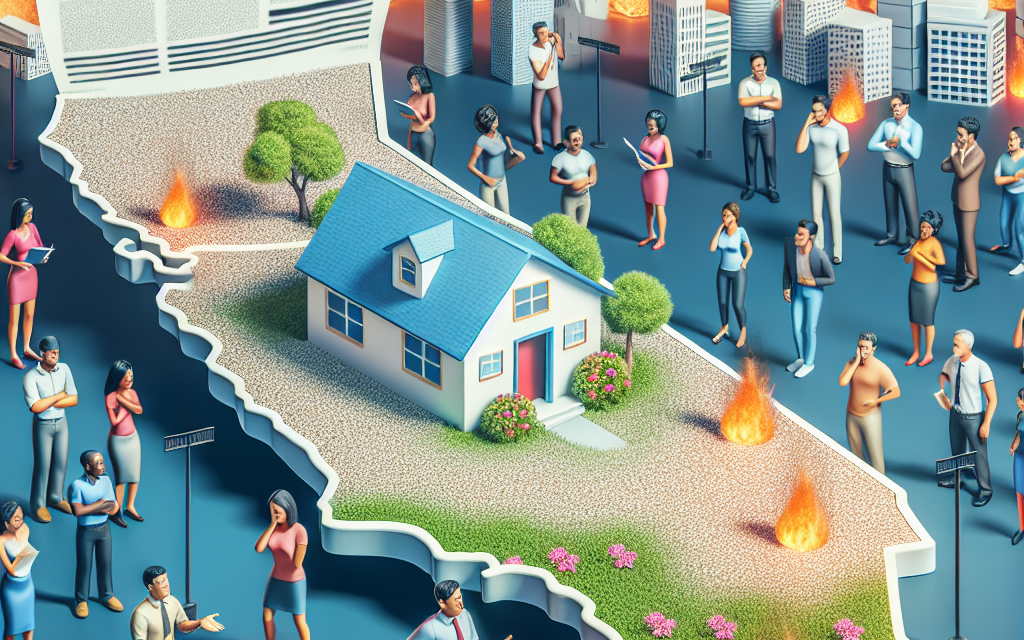“California Homeowners Insurance: Navigating Rising Risks Amid Relentless Wildfires.”
Introduction
California homeowners insurance is currently facing significant challenges due to the increasing frequency and intensity of wildfires across the state. As climate change exacerbates these natural disasters, insurers are grappling with rising claims and the need to reassess risk models. Many homeowners are experiencing higher premiums, reduced coverage options, or even difficulty obtaining insurance altogether. This evolving landscape not only impacts homeowners’ financial security but also raises concerns about the long-term viability of the insurance market in wildfire-prone areas. As the state continues to confront these environmental challenges, the future of homeowners insurance in California remains uncertain.
Rising Premiums Due to Increased Wildfire Risk
California homeowners insurance is currently navigating a complex landscape shaped by the increasing frequency and intensity of wildfires. As climate change continues to exacerbate these natural disasters, insurance companies are compelled to reassess their risk models, leading to a significant rise in premiums for homeowners across the state. This trend is not merely a reflection of market dynamics; it is a direct response to the heightened threat posed by wildfires, which have become a persistent and devastating reality for many communities.
In recent years, California has witnessed some of the most destructive wildfires in its history, with entire neighborhoods reduced to ashes and thousands of residents displaced. The aftermath of these catastrophic events has prompted insurers to reevaluate their exposure to risk. Consequently, many companies have begun to increase premiums substantially, a move that has left homeowners grappling with the financial implications. For many, the rising costs of insurance are becoming untenable, forcing them to make difficult decisions about their coverage options.
Moreover, the situation is further complicated by the fact that some insurers are opting to withdraw from high-risk areas altogether. This trend has created a significant gap in the market, leaving homeowners with fewer options and, in some cases, no coverage at all. As a result, those living in fire-prone regions are increasingly finding themselves in a precarious position, where the availability of affordable insurance is dwindling. This lack of options not only affects individual homeowners but also has broader implications for the housing market and community stability.
In light of these challenges, many homeowners are seeking ways to mitigate their risks and potentially lower their premiums. One effective strategy involves implementing fire-resistant measures around their properties, such as creating defensible space by clearing vegetation and using fire-resistant building materials. These proactive steps can not only enhance the safety of homes but may also lead to reduced insurance costs, as insurers often reward policyholders who take measures to minimize risk.
Additionally, homeowners are encouraged to shop around for insurance policies, as different companies may offer varying rates and coverage options. Engaging with local insurance agents who understand the unique challenges posed by California’s wildfire risk can also provide valuable insights. These professionals can help homeowners navigate the complexities of their insurance needs and identify potential savings.
Furthermore, the state of California is taking steps to address the insurance crisis by exploring regulatory changes aimed at stabilizing the market. Initiatives such as the California FAIR Plan, which provides basic fire insurance coverage for high-risk areas, are designed to ensure that homeowners have access to essential protection. However, these measures alone may not be sufficient to counteract the broader trends of rising premiums and limited availability.
In conclusion, the challenges facing California homeowners insurance amid ongoing wildfires are multifaceted and deeply intertwined with the realities of climate change. As premiums continue to rise and options dwindle, homeowners must remain vigilant in seeking solutions that protect their properties while also managing costs. The interplay between individual actions, market dynamics, and state-level interventions will ultimately shape the future of homeowners insurance in California, making it imperative for all stakeholders to engage in proactive discussions and strategies to navigate this evolving landscape.
Coverage Gaps for Homeowners in High-Risk Areas
California homeowners insurance is increasingly under scrutiny as the state grapples with the devastating impact of wildfires. In recent years, the frequency and intensity of these natural disasters have surged, prompting insurers to reassess their risk exposure and coverage offerings. As a result, homeowners in high-risk areas are finding themselves facing significant coverage gaps that can leave them vulnerable in the event of a disaster. This situation is particularly concerning given that many residents rely on their insurance policies as a safety net against the unpredictable nature of wildfires.
One of the primary challenges for homeowners in high-risk areas is the rising cost of premiums. Insurers, responding to the heightened risk associated with wildfires, have increased rates significantly. This escalation in costs can make it difficult for homeowners to afford adequate coverage, leading some to opt for policies with lower limits or higher deductibles. Consequently, these decisions can create a precarious situation where, in the event of a wildfire, homeowners may find themselves underinsured and unable to fully recover their losses.
Moreover, some insurance companies have begun to withdraw from high-risk markets altogether, leaving homeowners with fewer options. This trend has been particularly pronounced in regions that have experienced multiple wildfire events in recent years. As insurers exit these markets, homeowners may be forced to turn to less reputable companies or to purchase policies that offer limited coverage. This lack of competition can further exacerbate the problem, as remaining insurers may impose stricter underwriting criteria, making it even more challenging for homeowners to secure comprehensive coverage.
In addition to rising premiums and limited options, many homeowners are also discovering that their policies contain exclusions that can significantly impact their ability to recover from wildfire damage. For instance, some policies may exclude coverage for certain types of structures, such as detached garages or sheds, which can be critical for homeowners who rely on these spaces for storage or as living areas. Furthermore, policies may not cover the full cost of rebuilding a home to current building codes, which can be particularly problematic in areas where regulations have changed in response to wildfire risks.
As homeowners navigate these challenges, it is essential for them to conduct thorough reviews of their insurance policies. Understanding the specific terms and conditions of coverage can help homeowners identify potential gaps and take proactive steps to address them. For instance, homeowners may consider adding endorsements or riders to their policies that provide additional coverage for specific risks associated with wildfires. Engaging with insurance agents who specialize in high-risk areas can also provide valuable insights into available options and strategies for securing adequate protection.
In light of these ongoing challenges, it is crucial for policymakers to consider measures that can help stabilize the homeowners insurance market in California. Initiatives aimed at improving wildfire prevention and mitigation efforts, such as creating defensible space around properties and investing in community-wide firebreaks, can play a significant role in reducing overall risk. Additionally, exploring innovative insurance models, such as state-backed reinsurance programs, could provide a safety net for insurers and help ensure that homeowners have access to affordable coverage.
Ultimately, as California continues to confront the realities of climate change and its impact on wildfire frequency, addressing the coverage gaps for homeowners in high-risk areas will be essential. By fostering a more resilient insurance market and encouraging proactive risk management strategies, stakeholders can work together to protect homeowners and their properties from the devastating effects of wildfires.
The Impact of Wildfire Mitigation Efforts on Insurance Policies
California homeowners insurance is increasingly influenced by the state’s ongoing battle with wildfires, prompting a reevaluation of risk assessment and mitigation strategies. As wildfires become more frequent and intense due to climate change, insurance companies are compelled to adapt their policies to reflect the heightened risks associated with living in fire-prone areas. This adaptation is not merely a reaction to immediate threats; it also encompasses a broader understanding of how wildfire mitigation efforts can shape insurance policies and premiums.
In recent years, California has implemented various wildfire mitigation initiatives aimed at reducing the risk of catastrophic fires. These efforts include creating defensible space around properties, enforcing stricter building codes, and promoting community-wide fire prevention programs. While these measures are essential for protecting homes and lives, they also play a significant role in how insurance companies assess risk. Insurers are increasingly considering the effectiveness of local mitigation efforts when determining policy terms and premiums. For instance, homes located in communities that actively engage in fire prevention strategies may benefit from lower premiums, as insurers recognize the reduced likelihood of claims in these areas.
Moreover, the relationship between wildfire mitigation and insurance policies is further complicated by the concept of risk modeling. Insurers utilize sophisticated algorithms and data analytics to evaluate the potential for wildfire damage. These models take into account various factors, including vegetation density, historical fire patterns, and the proximity of homes to natural landscapes. As mitigation efforts evolve, insurers are updating their models to reflect the changing landscape of risk. This dynamic interaction means that homeowners who invest in fire-resistant materials or participate in community fire safety programs may find themselves in a more favorable position when it comes to securing insurance coverage.
However, the impact of wildfire mitigation on insurance policies is not uniformly positive. In some cases, insurers may still choose to limit coverage or increase premiums for properties in high-risk areas, regardless of local mitigation efforts. This trend can create a paradox where homeowners who take proactive steps to protect their properties still face challenges in obtaining affordable insurance. Consequently, many residents are left grappling with the reality that even the most diligent mitigation efforts may not guarantee favorable insurance terms.
Furthermore, the ongoing nature of wildfires in California raises questions about the long-term sustainability of current insurance models. As climate change continues to exacerbate wildfire risks, insurers may find it increasingly difficult to balance their financial viability with the need to provide coverage to homeowners. This situation could lead to a tightening of the insurance market, where fewer companies are willing to underwrite policies in high-risk areas, ultimately leaving homeowners with limited options.
In conclusion, the interplay between wildfire mitigation efforts and homeowners insurance policies in California is complex and multifaceted. While proactive measures can lead to more favorable insurance terms, the overarching challenges posed by climate change and the evolving nature of wildfire risks complicate this relationship. As homeowners navigate this landscape, it is crucial for them to remain informed about both mitigation strategies and the insurance market, ensuring they are prepared for the potential impacts of wildfires on their homes and financial security. Ultimately, a collaborative approach involving homeowners, insurers, and policymakers will be essential in addressing the challenges posed by wildfires and ensuring that adequate insurance coverage remains accessible and affordable.
Navigating Claims Process After a Wildfire
Navigating the claims process after a wildfire can be a daunting task for California homeowners, particularly in the wake of the increasing frequency and intensity of these natural disasters. As wildfires continue to ravage vast areas of the state, the implications for homeowners insurance are profound, necessitating a clear understanding of the claims process to ensure that affected individuals can recover effectively. When a wildfire strikes, the immediate aftermath often leaves homeowners grappling with loss and uncertainty, making it crucial to approach the claims process with a well-informed strategy.
Initially, it is essential for homeowners to document the damage thoroughly. This documentation serves as a critical foundation for any insurance claim. Taking photographs of the property, both before and after the wildfire, can provide invaluable evidence of the extent of the damage. Additionally, compiling a detailed inventory of personal belongings that were lost or damaged can further substantiate the claim. This step is vital, as insurance companies typically require comprehensive documentation to process claims efficiently. Therefore, homeowners should prioritize this task, even amidst the chaos that follows a wildfire.
Once the damage has been documented, the next step involves notifying the insurance company. Homeowners should contact their insurer as soon as possible to report the loss. Most insurance policies have specific timeframes within which claims must be filed, and delays can complicate the process. When reaching out to the insurance provider, it is advisable to have policy information readily available, as this can expedite the claims process. Furthermore, homeowners should inquire about the specific procedures and requirements for filing a claim related to wildfire damage, as these can vary significantly between insurers.
After filing the claim, homeowners may encounter an adjuster assigned by the insurance company. The adjuster’s role is to assess the damage and determine the amount of compensation that the homeowner is entitled to receive. It is important for homeowners to be prepared for this visit by having all documentation organized and accessible. Engaging in open communication with the adjuster can facilitate a smoother process, as they may have questions or require additional information to complete their assessment. Homeowners should also be aware of their rights during this process, including the right to appeal if they disagree with the adjuster’s findings.
In addition to dealing with the insurance company, homeowners may find it beneficial to seek assistance from local resources or organizations that specialize in disaster recovery. These entities can provide guidance on navigating the claims process and may offer support in understanding the nuances of insurance policies. Furthermore, they can connect homeowners with legal assistance if disputes arise with the insurance provider. Given the complexities often involved in claims related to wildfires, having access to expert advice can be invaluable.
Ultimately, while the claims process after a wildfire can be overwhelming, a methodical approach can help homeowners navigate the challenges they face. By documenting damage meticulously, communicating effectively with insurance providers, and seeking support from local resources, homeowners can enhance their chances of receiving fair compensation. As California continues to confront the realities of wildfires, understanding the intricacies of the claims process becomes increasingly essential for homeowners striving to rebuild their lives and properties in the aftermath of such devastating events.
The Role of State Regulations in Homeowners Insurance
California homeowners insurance is increasingly influenced by the state’s regulatory framework, particularly in the context of the ongoing wildfire crisis. As wildfires become more frequent and severe, the insurance landscape is evolving, prompting regulators to reassess existing policies and implement new measures aimed at protecting both consumers and insurers. This dynamic interplay between state regulations and the insurance market is crucial for understanding the challenges faced by homeowners in high-risk areas.
One of the primary roles of state regulations is to ensure that homeowners have access to affordable insurance options, even in regions prone to natural disasters. In California, the Department of Insurance plays a pivotal role in overseeing the insurance market, establishing guidelines that insurers must follow when determining rates and coverage. However, as the frequency of wildfires escalates, insurers are increasingly compelled to raise premiums or limit coverage, which can leave homeowners vulnerable. In response, state regulators have sought to balance the interests of consumers and insurers by implementing measures designed to stabilize the market while encouraging responsible risk management.
For instance, California has introduced regulations that require insurers to provide clear explanations of policy terms and conditions, ensuring that homeowners understand their coverage options. This transparency is essential, particularly in a state where many residents may not fully grasp the implications of living in a wildfire-prone area. By mandating that insurers disclose the risks associated with specific locations, regulators aim to empower homeowners to make informed decisions about their insurance needs.
Moreover, the state has also taken steps to promote wildfire mitigation efforts, recognizing that proactive measures can significantly reduce the risk of property damage. Programs that incentivize homeowners to invest in fire-resistant materials and landscaping are part of a broader strategy to enhance community resilience. By encouraging such initiatives, regulators not only help protect individual properties but also contribute to the overall stability of the insurance market. When homeowners take steps to mitigate risks, insurers may be more willing to offer coverage at reasonable rates, creating a win-win situation for all parties involved.
However, the regulatory landscape is not without its challenges. As insurers grapple with mounting losses due to catastrophic wildfires, some have opted to withdraw from high-risk markets altogether. This trend raises concerns about the availability of coverage for homeowners in vulnerable areas, prompting regulators to explore potential solutions. One approach has been the establishment of state-backed insurance programs designed to provide coverage for those unable to secure policies through traditional means. While these programs can offer a safety net, they also place additional financial burdens on the state, highlighting the delicate balance regulators must maintain.
In conclusion, the role of state regulations in homeowners insurance is increasingly critical as California faces the ongoing threat of wildfires. By fostering transparency, promoting risk mitigation, and exploring innovative insurance solutions, regulators aim to create a more resilient insurance market that can withstand the challenges posed by natural disasters. However, the evolving nature of these challenges necessitates ongoing dialogue between regulators, insurers, and homeowners to ensure that the needs of all stakeholders are met. As California continues to navigate this complex landscape, the effectiveness of regulatory measures will play a significant role in shaping the future of homeowners insurance in the state.
Strategies for Homeowners to Lower Insurance Costs
As California homeowners grapple with the increasing frequency and intensity of wildfires, the financial burden of homeowners insurance has become a pressing concern. In light of these challenges, it is essential for homeowners to explore effective strategies to lower their insurance costs while ensuring adequate coverage. By adopting a proactive approach, homeowners can mitigate expenses and enhance their financial resilience in the face of natural disasters.
One of the most effective strategies for reducing insurance premiums is to increase the deductible. A higher deductible means that homeowners will pay more out-of-pocket in the event of a claim, but it can significantly lower monthly premiums. Homeowners should carefully assess their financial situation to determine a deductible that balances affordability with risk tolerance. Additionally, it is advisable to review the policy details to understand how different deductible levels impact overall costs.
Another practical approach involves bundling insurance policies. Many insurance companies offer discounts to customers who purchase multiple types of coverage, such as homeowners and auto insurance, from the same provider. By consolidating policies, homeowners can not only simplify their insurance management but also take advantage of potential savings. It is prudent to shop around and compare quotes from various insurers to identify the best bundling options available.
Furthermore, enhancing home security and safety features can lead to lower insurance premiums. Insurance companies often provide discounts for homes equipped with security systems, smoke detectors, and fire-resistant materials. Homeowners should consider investing in these upgrades, as they not only protect the property but also demonstrate a commitment to risk reduction. Additionally, maintaining a well-kept landscape can minimize fire hazards, which may further influence insurance costs favorably.
In addition to physical improvements, homeowners should regularly review and update their insurance policies. As property values fluctuate and personal circumstances change, it is crucial to ensure that coverage levels are appropriate. Homeowners should conduct an annual review of their policies, taking into account any renovations, additions, or changes in local building codes. This proactive approach can help avoid over-insurance, which can unnecessarily inflate premiums.
Moreover, participating in community risk reduction programs can also yield financial benefits. Many insurers offer discounts to homeowners who engage in initiatives aimed at reducing wildfire risks, such as creating defensible space around properties or participating in local fire safety workshops. By collaborating with neighbors and local authorities, homeowners can not only enhance their own safety but also contribute to a broader community effort to mitigate wildfire risks.
Lastly, it is essential for homeowners to remain informed about the insurance market and emerging trends. Understanding the factors that influence insurance rates, such as climate change and regional risk assessments, can empower homeowners to make informed decisions. Engaging with insurance agents and seeking advice on policy options can also provide valuable insights into potential savings.
In conclusion, while the challenges posed by wildfires in California are significant, homeowners can take proactive steps to lower their insurance costs. By increasing deductibles, bundling policies, enhancing home safety features, regularly reviewing coverage, participating in community risk reduction efforts, and staying informed about the insurance landscape, homeowners can navigate the complexities of insurance in a changing environment. Ultimately, these strategies not only promote financial savings but also contribute to a more resilient and secure living environment.
Future Trends in California Homeowners Insurance Amid Climate Change
As California grapples with the increasing frequency and intensity of wildfires, the landscape of homeowners insurance is undergoing significant transformation. The interplay between climate change and insurance practices is becoming increasingly evident, prompting both insurers and homeowners to adapt to a new reality. In this context, future trends in California homeowners insurance are likely to be shaped by a combination of regulatory changes, technological advancements, and evolving consumer expectations.
One of the most pressing challenges facing homeowners insurance in California is the need for insurers to accurately assess risk in an environment where traditional models may no longer suffice. As wildfires become more unpredictable, insurance companies are investing in advanced data analytics and modeling techniques to better understand and anticipate potential losses. This shift towards data-driven decision-making is essential for insurers to remain solvent while providing coverage that meets the needs of homeowners. Consequently, we can expect to see a greater emphasis on risk assessment tools that incorporate real-time environmental data, allowing insurers to adjust premiums and coverage options based on the most current information.
Moreover, the regulatory landscape is also evolving in response to the challenges posed by climate change. California lawmakers are increasingly focused on ensuring that homeowners have access to affordable insurance options, even in high-risk areas. This has led to discussions about potential reforms to the California Fair Plan, which serves as a safety net for homeowners who cannot obtain coverage through traditional insurers. As policymakers seek to balance the interests of consumers and insurers, we may witness the introduction of new regulations aimed at promoting transparency in pricing and underwriting practices. Such measures could help to stabilize the market while ensuring that homeowners are adequately protected against the growing threat of wildfires.
In addition to regulatory changes, technological innovations are poised to play a crucial role in shaping the future of homeowners insurance in California. The rise of smart home technology, for instance, offers homeowners the opportunity to enhance their property’s resilience against wildfires. Devices such as fire detection systems, automated sprinkler systems, and even drones for monitoring nearby fire activity can significantly reduce risk. Insurers may begin to incentivize the adoption of these technologies by offering discounts on premiums for homeowners who implement fire mitigation measures. This trend not only benefits insurers by lowering potential claims but also empowers homeowners to take proactive steps in safeguarding their properties.
Furthermore, as awareness of climate change continues to grow, consumer expectations regarding sustainability and corporate responsibility are shifting. Homeowners are increasingly seeking insurance providers that demonstrate a commitment to environmental stewardship. Insurers that prioritize sustainable practices, such as investing in renewable energy or supporting community resilience initiatives, may find themselves at a competitive advantage. This trend could lead to the emergence of new insurance products that cater specifically to environmentally conscious consumers, further diversifying the market.
In conclusion, the future of homeowners insurance in California is likely to be characterized by a dynamic interplay of risk assessment advancements, regulatory reforms, technological innovations, and changing consumer expectations. As the state continues to confront the realities of climate change, both insurers and homeowners will need to adapt to ensure that coverage remains accessible and effective. By embracing these trends, the insurance industry can not only navigate the challenges posed by wildfires but also contribute to a more resilient and sustainable future for California’s communities.
Q&A
1. **What challenges are California homeowners facing regarding insurance due to wildfires?**
Homeowners are facing increased premiums, reduced coverage options, and difficulties in obtaining new policies due to the heightened risk of wildfires.
2. **How have wildfire risks affected insurance premiums in California?**
Insurance premiums have significantly increased as insurers adjust rates to account for the growing frequency and severity of wildfires.
3. **What options do homeowners have if they cannot find traditional insurance coverage?**
Homeowners may seek coverage through the California FAIR Plan, which provides basic fire insurance, or explore surplus lines insurers that specialize in high-risk properties.
4. **How are insurers responding to the ongoing wildfire threat?**
Insurers are tightening underwriting standards, limiting coverage, and in some cases, non-renewing policies in high-risk areas.
5. **What impact do wildfires have on the availability of homeowners insurance?**
The availability of homeowners insurance is declining in high-risk areas, making it challenging for homeowners to secure adequate coverage.
6. **Are there any state regulations affecting homeowners insurance in wildfire-prone areas?**
Yes, California has implemented regulations aimed at protecting homeowners, such as requiring insurers to provide clear explanations for policy non-renewals and rate increases.
7. **What can homeowners do to mitigate their risk and potentially lower insurance costs?**
Homeowners can take proactive measures such as creating defensible space around their properties, using fire-resistant building materials, and participating in community fire prevention programs.
Conclusion
California homeowners insurance is increasingly challenged by the ongoing threat of wildfires, leading to rising premiums, reduced coverage options, and a growing number of policy cancellations. Insurers are grappling with the financial impact of frequent and severe fire events, prompting a reevaluation of risk assessment and pricing models. As a result, homeowners may face difficulties in securing affordable and comprehensive coverage, highlighting the urgent need for policy reforms and innovative solutions to address the evolving landscape of wildfire risk in the state.





